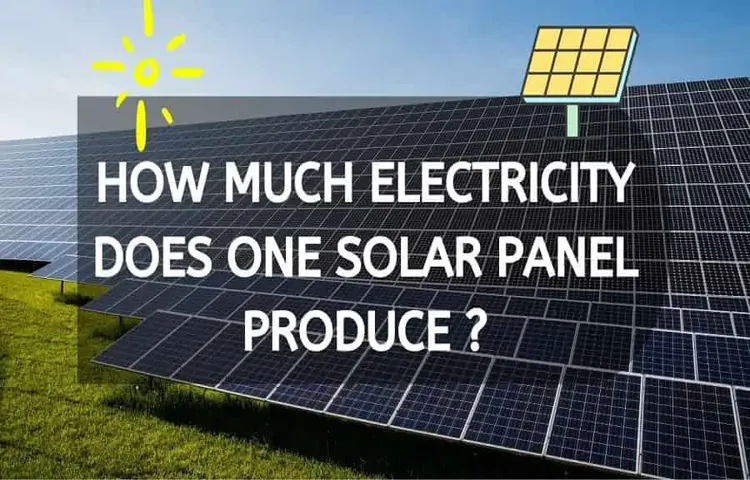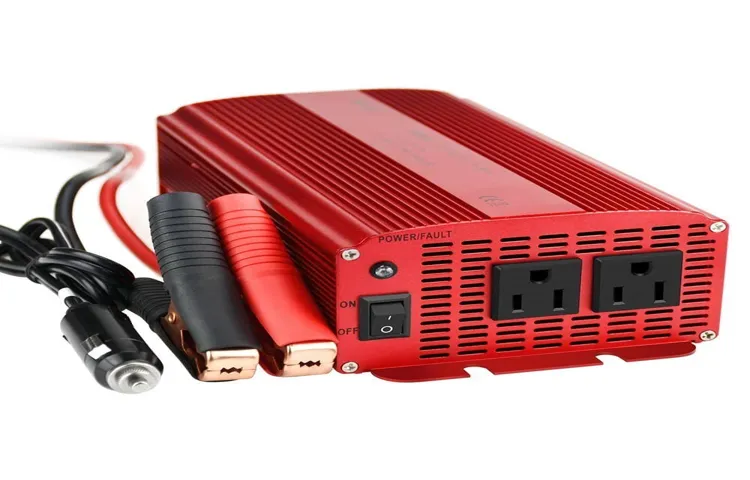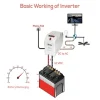Power inverters are fascinating devices that have become increasingly popular in recent years. But what exactly are they, and how do they work? In simplest terms, power inverters are devices that convert DC (Direct Current) electricity into AC (Alternating Current) electricity. This allows you to use your electronic devices, appliances, and tools that require AC power while on the go, or when there is no access to a traditional power source.
Imagine you’re on a road trip, and you want to charge your phone or use a laptop. Normally, you would need a socket or an outlet to do this, but what if you’re in the middle of nowhere, far away from any power source? This is where power inverters come into play. They take the 12V DC power supply from your vehicle’s battery and convert it into the 110V AC power that your electronic devices need.
It’s like having a portable electrical outlet wherever you go. Power inverters come in various sizes and power capacities, from small ones that can power a single device, like a laptop, to larger ones that can provide power for multiple devices simultaneously. They are incredibly versatile and can be used in a wide range of situations, from camping and boating trips to emergency backup power during power outages.
Understanding power inverters is not only useful for practical purposes, but it also gives you a deeper understanding of how electricity works. It’s like peeling back the layers of a complex puzzle and discovering the inner workings. So if you’ve ever been curious about power inverters, or if you’re looking for a portable power solution, keep reading as we delve deeper into the fascinating world of power inverters and how they can benefit you.
Table of Contents
What is a Power Inverter?
Power inverters are devices that convert DC power from a battery or solar panel into AC power, which is the type of power used by most household appliances and electronics. They are commonly used in RVs, boats, and off-grid solar systems to provide power for various devices and appliances. When it comes to the power consumption of an inverter, it depends on the size and capacity of the inverter, as well as the amount of power being drawn from it.
Generally, larger inverters with higher wattage capacities will consume more power. However, it’s important to note that even when not actively powering any devices, inverters will still consume a small amount of power to maintain their operation. Therefore, it’s essential to choose the right size inverter for your needs to ensure efficient power consumption.
Definition and Function
A power inverter is a device that converts DC (direct current) power from a battery or solar panel into AC (alternating current) power that can be used to run household appliances and electronic devices. Simply put, it takes the power from a car battery or a solar panel and transforms it into the type of power that can be used to charge your laptop, run a blender, or even power a small refrigerator. Think of it as a magic box that turns your portable power source into a versatile energy solution.
So, whether you’re camping in the great outdoors or facing a power outage at home, a power inverter is your go-to solution for generating the electricity you need.

Types of Power Inverters
power inverter.
Power Inverter Consumption
Have you ever wondered how much power an inverter consumes? Well, let me break it down for you. A power inverter is a device that converts DC (direct current) power from a battery to AC (alternating current) power, which is what most household appliances use. When it comes to power consumption, different inverters have different efficiencies.
The efficiency of an inverter refers to the percentage of power it can convert without any loss. Generally, most inverters have an efficiency of around 80% to 90%. This means that if you have a 1000-watt inverter, it will consume around 1100 to 1250 watts of power from your battery.
So, while the inverter itself does consume some power, the amount is relatively small compared to the power it provides.
Factors Affecting Power Inverter Consumption
power inverter consumption.
Calculating Power Inverter Consumption
power inverter consumption
Case Study: Power Inverter Consumption for a Laptop
power inverter consumption, laptop
Tips to Minimize Power Inverter Consumption
If you are wondering how much power does an inverter consume, you are not alone. Many people are concerned about minimizing the energy consumption of their power inverters. Fortunately, there are several tips you can follow to help reduce the power consumption of your inverter.
Firstly, consider the efficiency of the inverter. Look for inverters with higher efficiency ratings, as they will convert more of the power they consume into usable AC power. This will reduce the amount of power wasted and ultimately lower your electricity bill.
Secondly, be mindful of the size of your inverter. Choosing an inverter that is appropriately sized for your needs will ensure that it is not running unnecessarily at full capacity, which would consume more power. Lastly, consider the standby power consumption of your inverter.
Some inverters have a standby mode that still consumes power even when they are not actively being used. Look for inverters with lower standby power consumption or consider using a power switch to completely turn off the inverter when it is not in use. By following these tips, you can minimize the power consumption of your inverter and conserve energy.
Invest in Energy-Efficient Inverters
power inverter, energy-efficient inverters, minimize power inverter consumption, tips, invest in energy-efficient inverters. Investing in energy-efficient inverters is an excellent way to reduce power consumption and lower your energy bills. These devices convert DC power from a battery or solar panel into AC power that can be used to run household appliances and electronics.
By choosing an energy-efficient inverter, you can minimize power losses and maximize the efficiency of your electrical system. There are a few helpful tips to keep in mind when selecting an energy-efficient inverter. First, look for inverters with a high conversion efficiency rating, ideally above 90%.
This means that less power is lost during the conversion process, resulting in greater overall energy savings. Additionally, consider the inverter’s standby power consumption. Some inverters consume a significant amount of power when not in use, so selecting a model with low standby power usage is key.
Lastly, look for inverters that have been certified by energy efficiency organizations such as ENERGY STAR, as these models have been proven to meet high standards in energy efficiency. By investing in energy-efficient inverters, you can minimize power inverter consumption and save money on your energy bills.
Proper Sizing of Inverters
power inverter consumption, proper sizing of inverters, minimize power inverter consumption
Using Appliances Wisely
power inverter consumption, minimize power inverter consumption, tips to minimize power inverter consumption Using appliances wisely can greatly impact the consumption of power inverters in your home. Power inverters are used to convert DC power to AC power, allowing you to use appliances that require alternating current. However, power inverters can consume a significant amount of power themselves, leading to higher electricity bills.
To minimize power inverter consumption, there are several tips you can follow. First, consider the efficiency rating of the power inverter when purchasing one. Higher efficiency ratings mean less energy is wasted during the conversion process.
Additionally, only use the power inverter when necessary. Unplug it when not in use to avoid any standby power consumption. Another tip is to choose appliances that have a lower power requirement.
By using energy-efficient appliances, you can reduce the load on the power inverter and save electricity. Finally, consider using alternative power sources like solar panels or wind turbines, which can directly provide AC power without the need for an inverter. By implementing these tips, you can minimize power inverter consumption and save both energy and money.
Conclusion
In conclusion, the power inverter is like a sly vampire in disguise, quietly sipping away at the energy it receives from your car battery or solar panel. Just like Count Dracula, it requires a steady supply of energy to survive, converting it from DC to AC and enchantingly providing power to all your devices. However, unlike the dark lord vampire, the power inverter also possesses a considerate side, ensuring that energy is not wasted by shutting down when not in use.
So, next time you’re wondering how much power inverter consumes, remember that it’s like having a stylish and sophisticated vampire companion, consuming just the right amount of energy to keep the magic of electricity flowing without draining you dry!
FAQs
How much power does an inverter consume?
The power consumption of an inverter depends on its size or rating. Generally, smaller inverters with lower wattage ratings consume less power than larger ones. It is advisable to refer to the manufacturer’s specifications for the specific power consumption of an inverter.
What factors affect the power consumption of an inverter?
There are several factors that can influence the power consumption of an inverter, including the efficiency of the inverter, the load being powered by the inverter, and the duration of usage. Inverters with higher efficiencies will consume less power, while heavier loads and longer usage durations will result in higher power consumption.
How do I calculate the power consumption of an inverter?
To calculate the power consumption of an inverter, you can multiply the rated power capacity of the inverter in watts by the amount of time it will be used in hours. For example, if you have a 500-watt inverter that will be used for 3 hours, the power consumption would be 500 watts x 3 hours = 1500 watt-hours or 1.5 kilowatt-hours (kWh).
Are there any energy-saving features in inverters?
Some inverters may have energy-saving features such as automatic power-saving modes, which reduce power consumption when the load is low or when the inverter is not in use. Additionally, inverters with higher efficiencies inherently consume less power, resulting in energy savings.
Can solar inverters help reduce power consumption?
Solar inverters convert the DC power generated by solar panels into AC power for use in homes or businesses. By utilizing solar power, which is a renewable energy source, solar inverters can help reduce reliance on grid-based electricity and therefore contribute to lowering overall power consumption.
How can I minimize the power consumption of my inverter?
To minimize power consumption, you can opt for inverters with higher efficiency ratings, turn off the inverter when not in use, and avoid overloading the inverter with excessive loads. It is also important to ensure that the inverter is properly maintained and serviced to ensure optimal performance and efficiency.
Are there any standby power losses in inverters?
Some inverters may have standby power losses, which means they consume a small amount of power even when no load is connected. It is advisable to check the specifications of the inverter or consult the manufacturer to determine the standby power consumption and take it into account when calculating overall power usage.



